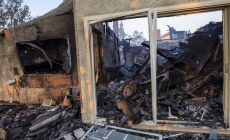-
Supreme Court Agrees to Hear Cases Involving Transgender Athletes - 20 hours ago
-
Santa Ana creates emergency fund for families harmed by ICE raids - 1 day ago
-
The Winners and Losers of Trump’s Big Bill, and a ‘60 Minutes’ Settlement - July 2, 2025
-
California Rolls Back Its Landmark Environmental Law - July 1, 2025
-
Teen Mt. Whitney hiker who walked off 120-foot cliff in delirium makes slow recovery, family says - June 30, 2025
-
Thom Tillis, Republican Senator, Won’t Seek Re-election Amid Trump’s Primary Threats - June 29, 2025
-
Better Half - June 28, 2025
-
Flaw in Edison equipment in Sylmar sparked major wildfires, lawyers say - June 28, 2025
-
‘F1’ Movie Finishes With $10M in Early Showings Ahead of Opening Weekend - June 28, 2025
-
Sauce Gardner Opens Up On Ice Spice Relationship, LeBron With The Assist! - June 28, 2025
L.A. wildfires cause $350 million in damage to city facilities
The wildfires that have torn through Pacific Palisades and other parts of Los Angeles this month have damaged or destroyed about $350 million in public infrastructure, including streetlights, recreation centers and a library that burned down, according to a city report.
The initial cost estimate, which examined damage from the first four days of the fires, was presented Wednesday to the City Council as part of a larger discussion on the impact of the emergency on the city budget.
City Administrative Officer Matt Szabo told council members that his office submitted the initial cost estimate to the Federal Emergency Management Agency as part of the process of securing all or partial reimbursement for fire- and wind-related damage. His office, which relied heavily on cost estimates from each city department, will work to refine the figures in the coming weeks.
“These are initial estimates,” he told the council. “They will likely grow.”
Szabo’s seven-page memo did not examine public infrastructure damaged or destroyed by the Eaton fire, which burned in Altadena and Pasadena — communities outside the city of Los Angeles. It also did not cover public buildings maintained by the Los Angeles Unified School District, the county of Los Angeles or other non-city agencies.

The ruins of Palisades Elementary Charter School in Pacific Palisades on Jan. 8.
(Genaro Molina / Los Angeles Times)
The vast majority of the damage to L.A. city infrastructure was attributed to the Palisades fire, which destroyed more than 6,600 structures and damaged 890 others, many of them in Pacific Palisades.
According to the report, the Department of Water and Power sustained nearly $76 million in damage, mostly to its power distribution system. Sanitation infrastructure, including pumping plants in nearly a dozen locations, sustained damage totaling nearly $48 million. The loss of the Pacific Palisades Public Library was estimated at $55 million.
FEMA typically assists local governments with disaster recovery by reimbursing 75% of damage costs, the city’s financial analysts said. In the final days of the Biden administration, federal officials agreed to reimburse the city for debris removal and emergency responses to the wildfires and the related windstorm at a rate of 100% — but only if that work took place within 180 days of the city’s emergency declaration.
On top of the damaged infrastructure, the city has estimated about $24 million in emergency response costs during the first 10 days of the wildfires — much of it for fire and police services.
It’s not clear whether FEMA’s approach to the city’s steadily growing emergency expenditures will change during the Trump administration. On Monday, President Trump issued an executive order directing federal officials to ensure that “sanctuary” jurisdictions that “seek to interfere” with immigration enforcement do not receive federal funds.
An aide to Hugo Soto-Martínez, one of the council members who proposed the city’s sanctuary law, said the city would not lose federal funding under such an order because its sanctuary law “does not interfere” with federal law enforcement. “Rather, it ensures that city resources and staff are not used to collaborate with immigration authorities,” the aide said.
Szabo said his office hopes to avoid tapping the city’s emergency reserve as much as possible, instead borrowing money from other funds until federal money arrives. That strategy was employed by the city during the pandemic emergency, when city workers provided COVID-19 testing and many other crucial services.
L.A. elected officials had been facing budget pressures well before the fires broke out. The city’s emergency reserve has fallen to $320 million, or about 4% of the city’s general fund budget, which pays for basic services like police patrols and emergency response. The city’s budget policy calls for that fund to remain at 5%.
Also on Wednesday, the council approved the creation of an ad hoc committee on windstorm and wildfire recovery to oversee rebuilding efforts and the distribution of state and federal aid.
Councilmember Traci Park, who represents Pacific Palisades, said the committee would focus not just on rebuilding but also on “restoring public faith in our city’s emergency and disaster response” system.
“For that reason, we will take these meetings to impacted communities, so we can make it easier and more convenient for residents to participate and have their voices heard,” she said.
Source link














